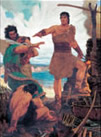Angel Robes
Chorus members representing the heavenly hosts wore a second robe over their basic robe. Drapes were not worn with the angel robe. Angel robes were made in a variety of styles and from more refined looking fabrics, such as lightweight drapery, chiffon, dupioni, and crepes. Colors used included light tans, creams and pale yellows. These colors appear white in stage lighting, whereas pure white becomes brilliant and reflective under stage lights and therefore was reserved for depicting angelic messengers and the Savior on stage. If considering other approaches to costuming angels, please see note about Adapting Costuming.

Gabriel and Angelic Messengers
Angelic messengers who descend from the colonnade to the stage floor, such as the angels to Joseph and the shepherds, the angels at the tomb, and the ascension angels, were given specific costumes to distinguish them from the chorus members in angel robes. These costumes were more tailored than a basic robe and included a large belt around the waist and a cowled neckline.

Gabriel wore the most fitted costume. His robe had set-in sleeves and was floor length. The drape had pleats across the shoulders that started in the belt at the waistline and spread out in a V shape to the shoulders. The belt gathered at the waist and fell in soft folds over the hips. It looked as if it were tied in the front with ties hanging nearly to the floor.
Because he only appeared on the colonnade, the angel to Nephi simply wore an angel robe over his basic costume.
Mary in Act One
Inspiration for Mary’s costume was taken directly from Carl Bloch’s painting Mary and the Angel (see Ensign article.) Her costume had the most vivid color: her robe was a cranberry red and her drape an evening blue. The fabrics for both pieces were soft and flowed well. Mary’s robe was hemmed long so that the robe could puddle slightly on the floor. The costume colors for the members of Mary’s family complimented and blended with hers.
Mary in Act Two
To look older, Mary wore a different costume in the second act. Her robe and drape for the second act were of similar colors but in grayed tones, and the fabrics were heavier with more body. Mary also wore a wimple to cover her head and shoulders. Her hair that was exposed was grayed, and she wore aged makeup.
Nephi
Unlike the rest of the prophets who were generally cast as mature men, Nephi was portrayed by a young man. He was also given a unique costume, inspired by Arnold Frieberg’s painting Nephi Subdues His Rebellious Brothers. Nephi wore an off-white, knee-length, short-sleeved robe with a cowl neckline. Over his robe he wore a leather-like sheath. He also wore a headband, gauntlets, a large belt similar to the one in the Frieberg painting, and sandals that laced up his legs.
Pregnancy Pads
Pregnancy pads are used by Elisabeth and Mary in Act One Scenes 2.3 and 3.3. These pieces were worn underneath their regular costumes and must be easy to get into and out of as there is little time for the actresses to add them between scenes.
Priests and Temple Boys
Priests wore a tabard-like drape over the left shoulder. The drape was pleated at the shoulder line and was held in place by a sash tied around the waist. Both drapes and sashes were made from tightly woven, smooth surfaced fabric in a muted grape color. Sashes were also trimmed with gold. Sashes were tied by placing the center on the belly button, crossing the ends behind the back, and bringing the ends forward to be tied in a square knot.
Head coverings were made from 1-yard squares of fabric folded diagonally. The bias fold was placed across the forehead with the ends twisted and knotted in back. The tails from the knot were twisted, crossed, and brought to the front of the head and secured. The remaining corners on the back of the head were separated, twisted, and tacked onto the knot on the back.
Temple boy’s tabards and belts were made from the same fabric. The tabards were rectangular pieces of fabric with a hole cut in the center for the boy’s head. Temple boys also wore sashes at the waist to hold their tabards in place.
Prophets
To distinguish prophets who speak from the colonnade—Malachi, Abinadi, Micah, Luke, and Samuel the Lamanite—from the ensemble, prophets wore off-white drapes over the basic robes, rather than wearing an angel robe. Costuming all prophets, except Nephi in this way unified their appearance, while the flexibility of how each drape was used still created individuality among them.
Roman Statesman and Soldiers
The Roman statesman wore a robe with a jumper over it, then a large drape around the body, and a drape over his shoulders that matched the soldiers. Roman soldiers wore knee-length robes with elbow-length sleeves. Their drapes were a cranberry red and were worn with cowl-like folds of drape in the front, while the ends of the drape fell from the shoulders down their backs. They also wore distinctive belts.
Shepherds
Shepherd costumes were created mostly in browns and greens. Robes and drapes were very rough, worn and frayed. Shepherd robes were shorter, from mid calf to below the knee. Pants were worn under the robe, laced to the lower legs with rope, shoelaces, or leather strips.
Wedding Scene
In the wedding scene Mary’s mother and Anna replace Mary’s light blue drape with an off-white drape and place a veil on her head. Prayer shawls—rectangles of off-white fabric with tassels on the corners—were worn by the adult men in the scene. The four boys who carry the canopy had smaller shawls of similar color but without tassels. Wedding wraps and prayer shawls are also noted on the props list because these items were added to the actors’ basic costumes while on stage.
 Return to the Costuming main page.
Return to the Costuming main page.








